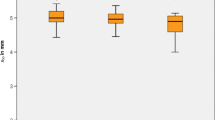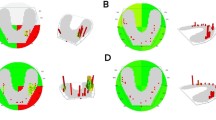Abstract
Aim
To evaluate the surface electromyography (sEMG) activity of the superficial masseter and anterior temporalis muscles at rest, during maximum voluntary clenching (MVC), and mastication, over 6 months of wearing clear thermoplastic or wrap-around retainers. Furthermore, the patients’ oral health-related quality of life was assessed using the Oral Impacts on Daily Performance (OIDP) index at 6 months.
Materials and methods
Sixty patients aged 14–39 years (19 males/41 females) who received upper and lower retainers after finishing orthodontic treatment were recruited. The patients were randomly divided into a clear thermoplastic retainer group (n = 30) or a wrap-around retainer group (n = 30). The sEMG activity was recorded at retainer delivery (T0), after 3 months (T1), and after 6 months of wearing (T2). The OIDP index was evaluated at T2.
Results
None of the sEMG parameters for the masseter and temporalis muscles were different between the two groups at T0, T1, or T2. Over the period of 6 months, both masticatory muscles in both groups demonstrated increased sEMG activity during MVC and mastication; however, only the temporalis muscle demonstrated decreased normalized sEMG activity at rest (P < 0.05). The frequency and severity of the OIDP in the eating aspect at T2 was low and similar in both groups.
Conclusions
sEMG activity of the two masticatory muscles tended to increase during MVC and mastication, while temporalis muscle activity tended to decrease at rest during the observation period, regardless of retainer type. Notably, these sEMG changes did not affect the patients’ subjective masticatory function.
Zusammenfassung
Ziel
Evaluierung der Oberflächen-Elektromyographie (sEMG) der Aktivität der oberflächlichen Masseter- und anterioren Temporalis-Muskeln in Ruhe, während des maximalen willkürlichen Zubeißens (MVC) und des Kauens über einen Zeitraum von 6 Monaten nach dem Tragen von durchsichtigen thermoplastischen bzw. Wrap-around-Retainern. Darüber hinaus wurde die mundgesundheitsbezogene Lebensqualität der Patienten nach 6 Monaten anhand des Oral Impacts on Daily Performance (OIDP)-Index bewertet.
Materialien und Methoden
Rekrutiert wurden 60 Patienten im Alter von 14-39 Jahren (19 Männer, 41 Frauen), die nach Abschluss einer kieferorthopädischen Behandlung mit oberen und unteren Retainern versorgt wurden. Die Patienten wurden nach dem Zufallsprinzip in eine Gruppe mit klaren thermoplastischen Retainern (n = 30) und eine Gruppe mit Wrap-around-Retainern (n = 30) eingeteilt. Die sEMG-Aktivität wurde bei der Abgabe des Retainers (T0), nach 3 Monaten (T1) und nach 6 Monaten Tragezeit (T2) aufgezeichnet. Der OIDP-Index wurde bei T2 ausgewertet.
Ergebnisse
Keiner der sEMG-Parameter für die Masseter- und Temporalis-Muskeln unterschied sich zwischen den beiden Gruppen bei T0, T1 oder T2. Über den Zeitraum von 6 Monaten zeigten beide Gruppen eine erhöhte sEMG-Aktivität während der MVC und des Kauens; jedoch zeigte nur der M. temporalis eine verringerte normalisierte sEMG-Aktivität in Ruhe (p < 0,05). Die Häufigkeit und der Schweregrad der OIDP im Essbereich bei T2 war gering und in beiden Gruppen ähnlich.
Schlussfolgerungen
Die sEMG-Aktivität der beiden Kaumuskeln nahm während der MVC und des Kauens tendenziell zu, während die Aktivität des Musculus temporalis in Ruhe während des Beobachtungszeitraums tendenziell abnahm, unabhängig vom Retainertyp. Bemerkenswert ist, dass diese sEMG-Veränderungen keinen Einfluss auf die subjektive Kaufunktion der Patienten hatten.




Similar content being viewed by others
References
Demir A, Babacan H, Nalcacı R, Topcuoglu T (2012) Comparison of retention characteristics of Essix and Hawley retainers. Korean J Orthod 42(5):255–262
Sheridan J, LeDoux W, McMinn R (1993) Essix retainers: fabrication and supervision for permanent retention. J Clin Orthod 27(1):37–45
Hichens L, Rowland H, Williams A, Hollinghurst S, Ewings P, Clark S, Ireland A, Sandy J (2007) Cost-effectiveness and patient satisfaction: Hawley and vacuum-formed retainers. Eur J Orthod 29(4):372–378
Outhaisavanh S, Liu Y, Song J (2020) The origin and evolution of the Hawley retainer for the effectiveness to maintain tooth position after fixed orthodontic treatment compare to vacuum-formed retainer: a systematic review of RCTs. Int Orthod 18(2):225–236
Moshkelgosha V, Shomali M, Momeni M (2016) Comparison of wear resistance of Hawley and vacuum formed retainers: an in-vitro study. J Dent Biomater 3(2):248
Rowland H, Hichens L, Williams A, Hills D, Killingback N, Ewings P, Clark S, Ireland AJ, Sandy JR (2007) The effectiveness of Hawley and vacuum-formed retainers: a single-center randomized controlled trial. Am J Orthod Dentofacial Orthop 132(6):730–737
Zhu Y, Lin J, Long H, Ye N, Huang R, Yang X, Jian F, Lai W (2017) Comparison of survival time and comfort between 2 clear overlay retainers with different thicknesses: a pilot randomized controlled trial. Am J Orthod Dentofacial Orthop 151(3):433–439
Begg P, Kesling P (1965) Begg orthodontic theory and technique. Philadelphia, London
Pativetpinyo D, Supronsinchai W, Changsiripun C (2018) Immediate effects of temporary bite-raising with light-cured orthodontic band cement on the electromyographic response of masticatory muscles. J Appl Oral Sci 26:e20170214
Manfredini D, Lombardo L, Vigiani L, Arreghini A, Siciliani G (2018) Effects of invisible orthodontic retainers on masticatory muscles activity during sleep: a controlled trial. Prog Orthod 19(1):1–5
Little RM, Wallen TR, Riedel RA (1981) Stability and relapse of mandibular anterior alignment—first premolar extraction cases treated by traditional edgewise orthodontics. Am J Orthod 80(4):349–365
Pedroni-Pereira A, Marquezin MCS, Araujo DS, Pereira LJ, Bommarito S, Castelo PM (2018) Lack of agreement between objective and subjective measures in the evaluation of masticatory function: a preliminary study. Physiol Behav 184:220–225
Castroflorio T, Icardi K, Torsello F, Deregibus A, Debernardi C, Bracco P (2005) Reproducibility of surface EMG in the human masseter and anterior temporalis muscle areas. Cranio 23(2):130–137
Cunningham SJ, Hunt NP (2001) Quality of life and its importance in orthodontics. J Orthod 28(2):152–158
Moher D, Hopewell S, Schulz KF, Montori V, Gøtzsche PC, Devereaux P, Elbourne D, Egger M, Altman DG (2012) CONSORT 2010 explanation and elaboration: updated guidelines for reporting parallel group randomised trials. Int J Surg 10(1):28–55
Schiffman E, Ohrbach R, Truelove E, Look J, Anderson G, Goulet J‑P, List T, Svensson P (2014) Diagnostic criteria for temporomandibular disorders (DC/TMD) for clinical and research applications: recommendations of the international RDC/TMD consortium network and orofacial pain special interest group. J Oral Facial Pain Headache 28(1):6–27
Johal A, Sharma NR, McLaughlin K, Zou L‑F (2014) The reliability of thermoform retainers: a laboratory-based comparative study. Eur J Orthod 37(5):503–507
Changsiripun C, Tokavanich N, Almeida FR (2019) Orthodontic removable appliance with posterior bite plane use is not associated with developing sleep-disordered breathing symptoms in healthy children. J Dent Child 86(3):145–149
Fueki K, Yoshida E, Sugiura T, Igarashi Y (2009) Comparison of electromyographic activity of jaw-closing muscles between mixing ability test and masticatory performance test. J Prosthodont Res 53(2):72–77
Hermens HJ, Freriks B, Disselhorst-Klug C, Rau G (2000) Development of recommendations for SEMG sensors and sensor placement procedures. J Electromyogr Kinesiol 10(5):361–374
Teenier TJ, Throckmorton GS, Ellis E III (1991) Effects of local anesthesia on bite force generation and electromyographic activity. J Oral Maxillofac Surg 49(4):360–365
Castroflorio T, Icardi K, Becchino B, Merlo E, Debernardi C, Bracco P, Farina D (2006) Reproducibility of surface EMG variables in isometric sub-maximal contractions of jaw elevator muscles. J Electromyogr Kinesiol 16(5):498–505
Changsiripun C, Pativetpinyo D (2020) Masticatory function after bite-raising with light-cured orthodontic band cement in healthy adults. Angle Orthod 90(2):263–268
Srisilapanan P, Sheiham A (2001) The prevalence of dental impacts on daily performances in older people in Northern Thailand. Gerodontology 18(2):102–103
Shrout PE (1998) Measurement reliability and agreement in psychiatry. Stat Methods Med Res 7(3):301–317
WoŸniak K, Piątkowska D, Lipski M, Mehr K (2013) Surface electromyography in orthodontics—a literature review. Med Sci Monit 19:416–423
Koc D, Dogan A, Bek B, Yucel M (2012) Effects of increasing the jaw opening on the maximum bite force and electromyographic activities of jaw muscles. J Dent Sci 7(1):14–19
Rugh JD, Drago CJ (1981) Vertical dimension: a study of clinical rest position and jaw muscle activity. J Prosthet Dent 45(6):670–675
Yoon W, Hwang S, Chung C, Kim K‑H (2017) Changes in occlusal function after extraction of premolars: 2‑year follow-up. Angle Orthod 87(5):703–708
Wang XR, Zhang Y, Xing N, Xu YF, Wang MQ (2013) Stable tooth contacts in intercuspal occlusion makes for utilities of the jaw elevators during maximal voluntary clenching. J Oral Rehabil 40(5):319–328
Varga S, Spalj S, Milosevic SA, Varga ML, Mestrovic S, Zrinski MT, Slaj M (2017) Changes of bite force and occlusal contacts in the retention phase of orthodontic treatment: a controlled clinical trial. Am J Orthod Dentofacial Orthop 152(6):767–777
Ferrario VF, Serrao G, Dellavia C, Caruso E, Sforza C (2002) Relationship between the number of occlusal contacts and masticatory muscle activity in healthy young adults. Cranio 20(2):91–98
Alkan Ö, Kaya Y, Keskin S (2020) Computerized occlusal analysis of Essix and Hawley retainers used during the retention phase: a controlled clinical trial. J Orofac Orthop 81(5):371–381
Mai W, Meng H, Jiang Y, Huang C, Li M, Yuan K, Kang N (2014) Comparison of vacuum-formed and Hawley retainers: a systematic review. Am J Orthod Dentofacial Orthop 145(6):720–727
Wan J, Wang T, Pei X, Wan Q, Feng W, Chen J (2017) Speech effects of Hawley and vacuum-formed retainers by acoustic analysis: a single-center randomized controlled trial. Angle Orthod 87(2):286–292
Tecco S, Mummolo S, Marchetti E, Tetè S, Campanella V, Gatto R, Gallusi G, Tagliabue A, Marzo G (2011) sEMG activity of masticatory, neck, and trunk muscles during the treatment of scoliosis with functional braces. A longitudinal controlled study. J Electromyogr Kinesiol 21(6):885–892
Acknowledgements
We thank Prof. Martin Tyas and Dr. Kevin Tompkins for their valuable suggestions and language revision.
Funding
This study was supported by Faculty Research Grant (DRF 62023), Faculty of Dentistry, Chulalongkorn University.
Author information
Authors and Affiliations
Corresponding author
Ethics declarations
Conflict of interest
R. Jirawiwatsaree, W. Supronsinchai and C. Changsiripun declare that they have no competing interests.
Ethical standards
All procedures performed in studies involving human participants or on human tissue were in accordance with the ethical standards of the institutional and/or national research committee and with the 1975 Helsinki declaration and its later amendments or comparable ethical standards. The study protocol was approved by the Human Research Ethics Committee of the Faculty of Dentistry, Chulalongkorn University (HREC-DCU 2019-008). Written informed consent to participate and for publication was obtained from the patients or their parents/legally authorized representatives [LAR] in the case of children under 18. The trial was registered in Thaiclinicaltrials.org under the identifier TCTR20190416001. The protocol was published on the Thaiclinicaltrials.org database before trial commencement.
Additional information
Publisher’s Note
Springer Nature remains neutral with regard to jurisdictional claims in published maps and institutional affiliations.
Rights and permissions
About this article
Cite this article
Jirawiwatsaree, R., Supronsinchai, W. & Changsiripun, C. Masticatory muscle activity and oral health-related quality of life in patients wearing clear thermoplastic versus wrap-around retainers. J Orofac Orthop 85, 56–68 (2024). https://doi.org/10.1007/s00056-022-00402-w
Received:
Accepted:
Published:
Issue Date:
DOI: https://doi.org/10.1007/s00056-022-00402-w




